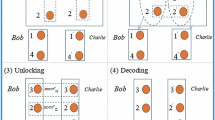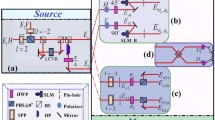Abstract
High channel capacity always plays an important role in quantum communication. Dense coding is an effective way to improve channel capacity, whose core idea is to apply as few particles as possible to carry information. Quantum entanglement exists not only between multiple particles but also in various degrees of freedom of a single-particle (intraparticle entanglement). Compared with the former (entanglement among multi-particles), firstly, the latter (intraparticle entanglement) can enable more bits of information to be transmitted in one-time communication by utilizing more degrees of freedom of single-particle. Secondly, the latter is more robust than the former. Thus, in this paper, based on the current experiment technology level, a scheme is designed to encode, transmit, and process 3 bits of classical information by applying the intraparticle entanglement state of a single-photon with three degrees of freedom in theory. Based on the literature survey, this scheme reaches the level at which a single-photon currently carries the most information with good security and robustness, and this work reveals a good idea for realizing superdense coding.



Similar content being viewed by others
Data Availability Statement
This manuscript has no associated data, or the data will not be deposited. [Authors comment: This is a theoretical work and analytical calculations are made. Therefore, no data are produced.]
References
H. Lai, J. Pieprzyk, M.X. Luo et al., High-capacity (2, 3) threshold quantum secret sharing based on asymmetric quantum lossy channels. Quantum Inf. Process 19, 5 (2020)
F. Steinlechner, S. Ecker, M. Fink et al., Distribution of high dimensional entanglement via an intra-city free-space link. Nat. Commun. 8, 15971 (2016)
R.T. Zhao, L.L. Cheng, High capacity information transmission with single-photon in polarization and spatial mode degrees of freedom over a collective noisy channel. Laser Phys. 30(6), 065204 (2020)
H.R. Wei, W.Q. Liu, N.Y. Chen, Implementing a two-photon three-degrees-of-freedom hyper-parallel controlled phase flip gate through cavity-assisted interactions. Ann. Phys. 532(4), 1900578 (2020)
L. Li, T. Wang, C. Wang, The analysis of high-capacity quantum secure direct communication using polarization and orbital angular momentum of photons. Mod. Phys. Lett. B 34, 2050017 (2020)
J. Cai, Z. Pan, T. Wang et al., High-capacity quantum secure direct communication using hyper-entanglement of photonic qubits. Int. J. Quantum Inf. 14, 1650043 (2016)
R.A. Kögler, L. Neves, Optimal Probabilistic Dense Coding Schemes (Kluwer Academic Publishers, New York, 2017)
Z.M. Huang, C. Zhang, H. Situ, Performance analysis of simultaneous dense coding protocol under decoherence. Quantum Inf. Process 16, 227 (2017)
J.T. Barreiro, T. Wei, P.G. Kwiat, Beating the channel capacity limit for linear photonic superdense coding. Nat. Phys. 4, 282–286 (2008)
M. Aili, A. Abulizi, Dense coding in a three-qubit heisenberg XXZ spin chain with three-site interactions. Int. J. Theor. Phys. 58, 364–371 (2018)
X.M. Hu, Y. Guo, B.H. Liu, Y.F. Huang, C.F. Li, G.C. Guo, Beating the channel capacity limit for superdense coding with entangled ququarts. Sci. Adv. 4(7), eaat9304 (2018)
Y.S. Zhou, F. Wang, M.X. Luo, Efficient superdense coding with W states. Int. J. Theor. Phys. 57(7), 1935–1941 (2018)
M. Pavicic, Deterministic mediated superdense coding with linear optics. Phys. Lett. A 380(8), 848–855 (2016)
F. Wu, G. Yang, H. Wang, High-capacity quantum secure direct communication with two-photon six-qubit hyperentangled states. Sci. China Phys. Mech. Astron. 60(12), 1–7 (2017)
J.T. Barreiro, N.K. Langford, N.A. Peters, P.G. Kwiat, Generation of hyperentangled photon pairs. Phys. Rev. Lett. 95(26), 260501 (2005)
E. Nagali, F. Sciarrino, F.D. Martini et al., Quantum information transfer from spin to orbital angular momentum of photons. Phys. Rev. Lett. 103, 013061 (2009)
L. Chen, W. She, Sorting photons of different rotational doppler shifts (RDS) by orbital angular momentum of single-photon with spin-orbit-RDS entanglement. Opt. Express 16, 14629–14634 (2008)
Y. Hasegawa, R. Loidl, G. Badurek, Violation of a bell-like inequality in single-neutron interferometry. Nature 425, 45–48 (2003)
E. Karimi, J. Leach, S. Slussarenko, Spin-orbit hybrid entanglement of photons and quantum contextuality. Phys. Rev. A 8250, 8932–8932 (2010)
J.M. Tang, Q.S. Zeng, Luo, et al., The relationship between single-particle commuting observables Lz, Sz entangled states and the spin–orbit coupling. Quantum Inf. Process. 19(1), 1–18 (2020)
T. Pramanik, S. Adhikari, A.S. Majumdar et al., Information transfer using a single particle path-spin hybrid entangled state. Phys. Lett. A 374, 1121–1125 (2010)
M.Q. Ruan, J.Y. Zeng, Complete sets of commuting observables of greenberger-horne-zeilinger states. Phys. Rev. A 70, 218–221 (2004)
M. Fiorentino, F.N.C. Wong, Deterministic controlled-NOT gate for single-photon two-qubit quantum logic. Phys. Rev. Lett. 93(7), 70502 (2004)
J. Leach, M.J. Padgett, S.M. Barnett et al., Measuring the orbital angular momentum of a single photon. Phys. Rev. Lett. 88, 257901 (2002)
R. Ionicioiu, I. D’Amico, Mesoscopic Stern-Gerlach device to polarize spin currents. Phys. Rev. B 67, 106–110 (2003)
L. Zhou, Y.B. Sheng, G.L. Long, Device-independent quantum secure direct communication against collective attacks. Sci. Bull. 65(1), 12–20 (2020)
K. Ekert, Artur, Quantum cryptography based on Bell’s theorem. Phys. Rev. Lett. 67, 661 (1991)
T.J. Wang, T. Li, F.F. Du et al., High-capacity quantum secure direct communication based on quantum hyperdense coding with hyperentanglement. Chin. Phys. Lett. 28, 32–35 (2011)
D. Liu, J.L. Chen, W. Jiang, High-capacity quantum secure direct communication with single photons in both polarization and spatial-mode degrees of freedom. Int. J. Theor. Phys. 51, 2923–2929 (2012)
S. Hassanpour, M. Houshmand, Efficient controlled quantum secure direct communication based on GHZ-like states. Quantum Inf. Process. 14, 739–753 (2015)
D. Shen, W. Ma, M. Wang, X. Yin, Improvement of a controlled quantum secure direct communication protocol. Modern Phys. Lett. B 28(15), 1450121 (2014)
G. Rigolin, Superdense coding using multipartite states. Physics (2004)
A. Hillebrand, Superdense coding with GHZ and quantum key distribution with W in the ZX-calculus. Elec. Proce. Theor. Comp. Scien. 95, 103–121 (2012)
P. Agrawal, A. Pati, Perfect teleportation and superdense coding with W states. Phys. Rev. A 74(6), 062320 (2006)
D. Saha, P.K. Panigrahi, N-qubit quantum teleportation, information splitting and superdense coding through the composite GHZ–Bell channel. Quantum Inf. Process 11(2), 615–628 (2012)
W. Zhang, D. Ding, Y. Sheng et al., Quantum secure direct communication with quantum memory. Phys. Rev. Lett. 118, 220501 (2017)
Y.N. Sun, Z.D. Liu, J. Sun et al., experimental realization of dimension witnesses based on quantum state discrimination. Phys. Rev. A 94(5), 052313 (2016)
L. Marrucci, E. Karimi, S. Slussarcnko et al., Spin-to-orbital conversion of the angular momentum of light and its classical and quantum applications. J. Opt. UK 13, 064001 (2011)
L. Marrucci, C. Manzo, D. Paparo, Optical spin-to-orbital angular momentum conversion in inhomogeneous anisotropic media. Phys. Rev. Lett. 96, 163905 (2006)
W.Y. Feng, D.Z. Fu, Y.L. Wang et al., Survey on the methods of detecting the orbital angular momentum of a vortex beam. Phys. Exp. 39, 1–12 (2019)
W.D. Yang, X.D. Qiu, L.X. Chen, Research progress in detection, imaging, sensing, and micromanipulation application of orbital angular momentum of beams. Chin. J. Lasers 47(5), 216–232 (2020)
J.M. Tang, Q.S. Zeng, Y. Wu et al., Low-decoherence quantum information transmittal scheme based on the single-particle various degrees of freedom entangled states. Quantum Inf. Process. 19(10), 389 (2020)
P. Saha, D. Sarkar, Robustness measure of hybrid intra-particle entanglement, discord, and classical correlation with initial werner state. Quantum. Inf. Process 15(2), 791–807 (2016)
Acknowledgments
The authors acknowledge our colleagues at Nanjing University of Aeronautics and Astronautics (NUAA) for their discussion and comments on this manuscript.
Author information
Authors and Affiliations
Contributions
All the authors were involved in the preparation of the manuscript. All authors have read and approved the final manuscript.
Corresponding author
Ethics declarations
Conflict of interest
The authors declare no conflicts of interest.
Rights and permissions
Springer Nature or its licensor holds exclusive rights to this article under a publishing agreement with the author(s) or other rightsholder(s); author self-archiving of the accepted manuscript version of this article is solely governed by the terms of such publishing agreement and applicable law.
About this article
Cite this article
Tang, J., Zeng, Q., Feng, N. et al. Superdense coding based on intraparticle entanglement states. Eur. Phys. J. D 76, 172 (2022). https://doi.org/10.1140/epjd/s10053-022-00491-7
Received:
Accepted:
Published:
DOI: https://doi.org/10.1140/epjd/s10053-022-00491-7




